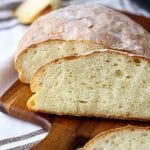Homemade Potato Bread
A slice of freshly baked homemade potato bread is the best! Soft and fluffy on the inside with crust that softens once it cools down makes it perfect for kids as well.
Servings: 1 large loaf (or 2 small loaves)
Calories: 106
Ingredients
- 3 cups strong bread flour , spooned & leveled, see note 1 (420 grams)
- 1 tablespoon granulated sugar
- 1½ teaspoons salt , see note 2
- 2¼ teaspoons instant yeast , see note 3 (7 grams)
- 2 cups mashed potatoes , see note 4
- 1 tablespoon olive oil , see note 5 (optional)
- ⅓ cup lukewarm water , see note 6 (70-80 milliliters)
Instructions
- For stand mixer with hook attachment: In a bowl of your stand mixer, add flour, sugar, salt and yeast. Mix well with a wooden spoon. Add mashed potatoes and turn on the mixer for a minute. Slowly, pour in water and oil. Knead for about 3-4 minutes, or until well combined.
- For hand-kneading: In a large bowl, combine flour, sugar, salt and yeast. Mix well. Add mashed potatoes. With your hands, combine everything together, until you get a crumb-like texture. Add water and oil and form into a dough. Transfer the dough onto a clean, lightly floured worktop and knead for 5-7 minutes. Spray the same bowl with some oil and place the dough back in (no need to wash it).
- For both: Cover the bowl with plastic foil and a clean kitchen towel. Transfer it to the warmest place in your house and let it rise (proof) until doubled in size, about 60 minutes (see note 7).
- When ready, transfer the dough onto a well-floured worktop and knead several times to get a smooth loaf. Shape the loaf into a long sausage.
- Place it onto a baking tray lined with baking parchment. Make several cuts with a knife on top and sprinkle with flour. Cover with a clean kitchen towel and let it rise for about 20 minutes. At the same time, turn on the oven and preheat it to 400 Fahrenheit (200 Celsius).
- Bake for 35 minutes or until the crust is hard, has a nice brown color and if you knock on the bottom of the loaf you hear a hollow sound.
- Cool down before slicing.
Notes
- Strong flour can be substituted with all-purpose (plain flour) without a problem.
- Salt – I used classic table salt. If using leftover mashed potatoes, you might need to reduce the salt as the mash is more likely already well-seasoned.
- Yeast – Active dry yeast can also be used and so can fresh yeast. Both should be activated in water (use the 1/3 cup + sugar). You will need 2¼ teaspoons of active dry yeast or with 0.7-ounce/20-grams fresh yeast.
- Potatoes – 2 cups are about 1.5-pounds (700-grams) of potatoes (uncooked). Use any you have on hand. You can also use less than 2 cups (i.e. 1.5 cups, but slightly more liquid will be needed). Always add a little at a time, like a tablespoon of water. Then mix and add more only if needed.
- If you omit olive oil, add an extra tablespoon of water.
- You may or may not need to add slightly more water to the dough. This is because the moisture in the flour, potatoes, and area you live in can vary. At first, it may look to you that the dough is dry and way more water is needed. Be careful, and wait a bit until the kitchen mixer mixes the dough for a while before you decide to add some more. The potatoes should make the dough very pliable, in fact, with 1/3 cup of water, it will be quite sticky.
- The proofing time can vary depending on how warm your house is. In general, count with 60 minutes, but it can take from 40 (extremely warm places) up to 90 minutes (cold places – especially in winter).
- Storage – this potato bread keeps well for several days (up to 5 days) when stored in a bread bag or container. Make sure to let it cool down completely before storing!
- Crust – the crust should be hard when you take the bread out from the oven but will soften when cooling down.
- No eggs, milk, or butter – this recipe does not contain any dairy products. However, you can use your leftover mashed potatoes where you might have already added some of the mentioned ingredients.
- To troubleshoot or if in doubt, please read the detailed post above this recipe card.
Nutrition Facts
Homemade Potato Bread
Serving Size
1 slice
Amount per Serving
Calories
106
% Daily Value*
Fat
1
g
2
%
Saturated Fat
1
g
6
%
Sodium
202
mg
9
%
Potassium
108
mg
3
%
Carbohydrates
22
g
7
%
Fiber
1
g
4
%
Sugar
1
g
1
%
Protein
4
g
8
%
Vitamin A
1
IU
0
%
Vitamin C
5
mg
6
%
Calcium
6
mg
1
%
Iron
1
mg
6
%
* Percent Daily Values are based on a 2000 calorie diet.
Did you make this recipe?I love hearing from you when you've made one of my recipes! Tag me on Instagram at @happyfoodstube or leave me a comment below.
